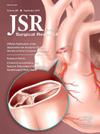Comprehensive Review and Management Strategies of Airway Complications Post-lung Transplantation
IF 1.7
3区 医学
Q2 SURGERY
引用次数: 0
Abstract
Introduction
Airway complications following lung transplantation are a major cause of morbidity (2%-18%) and mortality (2%-4%). These complications include necrosis, dehiscence, granulation tissue, bronchial stenosis, tracheobronchomalacia, fistulas, and infections. Donor bronchial ischemia, aggravated by poor graft preservation, prolonged mechanical ventilation, and donor–recipient size mismatch, is the primary driver. Although advances in bronchoscopic surveillance and endobronchial therapies have improved outcomes, airway complications remain a significant clinical challenge.
Materials and Methods
We performed a comprehensive review of the literature focusing on classification systems, risk factors, pathophysiology, diagnostic strategies, and management of airway complications post–lung transplantation. Emphasis was placed on recent innovations in surgical and bronchoscopic interventions, as well as consensus recommendations such as the International Society for Heart and Lung Transplantation classification system.
Results
Airway complications have decreased substantially in incidence compared to earlier decades, yet they continue to contribute to early and late post-transplant morbidity and mortality. Advances in organ preservation, refined surgical techniques, and early bronchoscopic surveillance have reduced ischemia-related complications. Endoscopic interventions such as balloon dilation, cryotherapy, and stenting remain cornerstones of management, while newer strategies including biodegradable stents, tissue-engineered scaffolds, and novel adhesives offer promise but require further validation. Despite these improvements, the absence of standardized bronchoscopic grading and the risk of stent-related complications remain key limitations.
Conclusions
Effective management of airway complications requires early detection and a multidisciplinary approach integrating surgery, interventional pulmonology, and optimized immunosuppression. While recent innovations have improved patient outcomes, consensus on standardized diagnostic systems and long-term strategies remains lacking. Continued research is essential to further reduce complication rates and improve the quality of life of lung transplant recipients.
肺移植术后气道并发症的综合评价及处理策略。
肺移植术后气道并发症是发病率(2%-18%)和死亡率(2%-4%)的主要原因。这些并发症包括坏死、裂开、肉芽组织、支气管狭窄、气管支气管软化、瘘管和感染。供体支气管缺血,由于移植物保存不良、机械通气时间延长和供体-受体尺寸不匹配而加剧,是主要的驱动因素。尽管支气管镜监测和支气管内治疗的进展改善了预后,但气道并发症仍然是重大的临床挑战。材料和方法:我们对肺移植后气道并发症的分类系统、危险因素、病理生理学、诊断策略和处理进行了全面的文献回顾。重点是外科和支气管镜干预的最新创新,以及国际心肺移植学会分类系统等共识建议。结果:与前几十年相比,气道并发症的发生率大幅下降,但它们继续导致移植后早期和晚期的发病率和死亡率。器官保存的进步、精细的手术技术和早期支气管镜监测减少了缺血相关并发症。内镜干预,如球囊扩张、冷冻疗法和支架置入术仍然是治疗的基础,而包括可生物降解支架、组织工程支架和新型粘合剂在内的新策略提供了希望,但需要进一步验证。尽管有这些改进,但缺乏标准化的支气管镜分级和支架相关并发症的风险仍然是主要的限制。结论:气道并发症的有效管理需要早期发现和多学科方法,包括外科手术、介入肺学和优化的免疫抑制。虽然最近的创新改善了患者的治疗效果,但在标准化诊断系统和长期战略方面仍然缺乏共识。持续的研究对于进一步降低并发症发生率和提高肺移植受者的生活质量至关重要。
本文章由计算机程序翻译,如有差异,请以英文原文为准。
求助全文
约1分钟内获得全文
求助全文
来源期刊
CiteScore
3.90
自引率
4.50%
发文量
627
审稿时长
138 days
期刊介绍:
The Journal of Surgical Research: Clinical and Laboratory Investigation publishes original articles concerned with clinical and laboratory investigations relevant to surgical practice and teaching. The journal emphasizes reports of clinical investigations or fundamental research bearing directly on surgical management that will be of general interest to a broad range of surgeons and surgical researchers. The articles presented need not have been the products of surgeons or of surgical laboratories.
The Journal of Surgical Research also features review articles and special articles relating to educational, research, or social issues of interest to the academic surgical community.

 求助内容:
求助内容: 应助结果提醒方式:
应助结果提醒方式:


